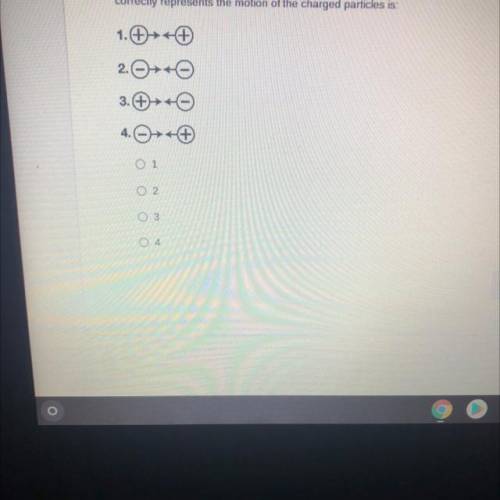
Physics, 17.03.2021 23:40, crystalclear99
The diagrams below in which arrows indicate the direction of movement represent charged particles placed near one another. The diagram that correctly represents the motion of the charged particles


Answers: 3
Other questions on the subject: Physics

Physics, 22.06.2019 09:50, trobbie817
A250-n box is at rest on a frictionless horizotal floor. then a person shoves the box with a non-zero force of magnitude p. which statement best describes the relationship betweeen p and the motion of the box after it was shoved? -the box will not move when p< 250n but otherwise will accelerate at a constant rate that is directly proportional to p - the box will begin moving at a speed that is directly proportional to p, then will gradually slow to a halt -the box will move with constant velocity at a speed that is directly proportional to p -box will accelerate across the floor at a constant rate that is directly proportional to p
Answers: 1

Physics, 22.06.2019 11:00, kayla65u
I'm thinking it's 2 you are asked to explain the earth's magnetic field. which is the best reply? 1. the earth's magnetic south is similar to the north pole of a magnet. 2. the earth's core has a strong magnetic charge similar to the south pole of a magnet. 3. the earth's geomagnetic south is similar to the south pole of a magnet. 4. the earth's magnetic charge is not centered at either pole; it varies based on location.
Answers: 1

Physics, 22.06.2019 12:30, olsen6932
As part of your daily workout, you lie on your back and push with your feet against a platform attached to two stiff springs arranged side by side so that they are parallel to each other. when you push the platform, you compress the springs. you do an amount of work of 79.0 j when you compress the springs a distance of 0.230 m from their uncompressed length. (a) what magnitude of force must you apply to hold the platform in this position? (b)how much additional work must you do to move the platform a distance 0.230 m farther? (c) what maximum force must you apply to move the platform a distance 0.230 m farther?
Answers: 1

Physics, 22.06.2019 20:30, nae467
Suppose a force of 60 n is required to stretch and hold a spring 0.1 m from its equilibrium position. a. assuming the spring obeys hooke's law, find the spring constant k. b. how much work is required to compress the spring 0.5 m from its equilibrium position? c. how much work is required to stretch the spring 0.6 m from its equilibrium position? d. how much additional work is required to stretch the spring 0.1 m if it has already been stretched 0.1 m from its equilibrium? a. kequals 600
Answers: 2
Do you know the correct answer?
The diagrams below in which arrows indicate the direction of movement represent charged particles pl...
Questions in other subjects:

History, 12.07.2021 20:10

Mathematics, 12.07.2021 20:10





English, 12.07.2021 20:10

Mathematics, 12.07.2021 20:10

History, 12.07.2021 20:10

Mathematics, 12.07.2021 20:10






